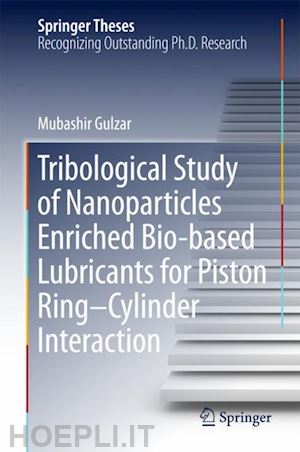
Questo prodotto usufruisce delle SPEDIZIONI GRATIS
selezionando l'opzione Corriere Veloce in fase di ordine.
Pagabile anche con Carta della cultura giovani e del merito, 18App Bonus Cultura e Carta del Docente
This thesis investigates the tribological viability of bio-based base stock to which different nanoparticles were incorporated for engine piston-ring–cylinder-liner interaction. It determines experimentally the effects of lubricating oil conditions (new and engine-aged) on the friction and wear of the materials used for piston rings and cylinder liners. The specific base stock examined was a trimethylolpropane (TMP) ester derived from palm oil, and the nanoparticles were used as additives to obtain tribologically enhanced bio-based lubricants. The overall analysis of the results demonstrated the potential of nanoparticles to improve the tribological behavior of bio-based base stock for piston-ring–cylinder-liner interaction.
Dr. Mubashir Gulzar obtained his Mechanical Engineering degree (B.Sc), at NUST University, Pakistan, in 2009. He continued to pursue his M.Sc. in Engine Tribology from the same university and graduated as the first graduate of NUST School of Mechanical and Manufacturing Engineering in 2011. Dr. Gulzar completed his doctoral studies in Engine Tribology from University of Malaya, Malaysia, in 2017. He worked as faculty member at NUST College of Electrical and Mechanical Engineering, Pakistan (Jan 2012 to Feb 2018).
He is currently appointed as Assistant Professor at Mechanical Engineering Department, Khwaja Fareed University of Engineering and Information Technology, Rahim Yar Khan, Pakistan.
Dr. Gulzar is an active researcher, published more than 45 articles including 24 high impact ISI indexed publications. He is a reviewer of top ranked journals and member of national as well as international engineering councils/societies.










Il sito utilizza cookie ed altri strumenti di tracciamento che raccolgono informazioni dal dispositivo dell’utente. Oltre ai cookie tecnici ed analitici aggregati, strettamente necessari per il funzionamento di questo sito web, previo consenso dell’utente possono essere installati cookie di profilazione e marketing e cookie dei social media. Cliccando su “Accetto tutti i cookie” saranno attivate tutte le categorie di cookie. Per accettare solo deterninate categorie di cookie, cliccare invece su “Impostazioni cookie”. Chiudendo il banner o continuando a navigare saranno installati solo cookie tecnici. Per maggiori dettagli, consultare la Cookie Policy.